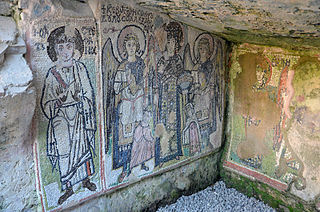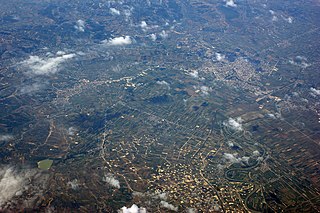
The Persqopi Castle is a 4th century BC era Illyrian ancient city, located near modern Tirana, Albania.

The Persqopi Castle is a 4th century BC era Illyrian ancient city, located near modern Tirana, Albania.
The Persqopi settlement can be dated to the second half of the 4th century BC. No ancient author mentions it by its Perqopi current name. It is thought to have been lived by the Illyrian tribe of the Parthini. The ancient city is on one side of the Vila Mountain, which is the last peak of the Krrabë mountain range. At 590 m over the level of sea, its strategic position facilitated the control of a large territory of the roads around the mountain. Its fortifying wall is one of the best preserved in the Albanian territory, and is 60 m long and 7 m high. There are 10 lines of stones. The entrance is 2.6 m large and is the only one that can still be seen today. [1] [2]
There are two adjacent walls (an external and an internal one). The external wall is 2m thick and the internal one 1m thick. The connection of the two walls to one another is through perpendicular additional walls, built at a 5.6 – 6.1 m distance from each another. The empty spaces created between the walls are filled with soil and stones of different dimensions, which creates an emplecton type of wall. Besides the ancient walls, in Persqop are conserved traces of multiple dwellings, as well as remains of an ancient tomb. In addition, there is an aqueduct, which provided water from the Vila Mountain. [1] [2]
Funding became available to the Albanian Fund for Development in 2011 for a feasibility study to build a road to the site, as well as to make the site an archaeological attraction, however until now neither project has been completed. [3]

Durrës is the second most populous city of the Republic of Albania and seat of Durrës County and Durrës Municipality. It is one of Albania's continuously inhabited cities, with roughly 2,500 years of recorded history. It is located on a flat plain along the Albanian Adriatic Sea Coast between the mouths of the Erzen and Ishëm at the southeastern corner of the Adriatic Sea. Durrës' climate is profoundly influenced by a seasonal Mediterranean climate.

Tourism in Albania has been a key element to the country's economic activity and is constantly developing. It is characterized by its rich archaeological and cultural heritage dating back to the classical period when Illyrians and Ancient Greeks inhabited the region. Over the course of history, the territory of0 Albania was occupied and populated by Romans, Byzantines, Venetians and Ottomans. Notably the country features unspoiled beaches, mountainous landscapes, traditional cuisine, archaeological artifacts, unique traditions, low prices and the wild atmosphere of the countryside.

Lezhë is a city in the Republic of Albania and seat of Lezhë County and Lezhë Municipality. It is one of Albania's continuously inhabited cities, with roughly 2,200 years of recorded history.

Fier is the seventh most populous city of the Republic of Albania and seat of Fier County and Fier Municipality. It is situated on the bank of Gjanica River in the Myzeqe Plain between the Seman in the north, the Vjosë in the south and the foothills of the Mallakastra Mountains in the southeast. Fier experiences a seasonal Mediterranean climate effected by its proximity to the Adriatic Sea in the west.

Tirana County, officially the County of Tirana, is a county in the Central Region of the Republic of Albania. It is the tenth largest by area and the most populous of the twelve counties, with more than 912,000 people within an area of 1,652 km2 (638 sq mi). The county borders on the Adriatic Sea to the west, the counties of Durrës to the northwest, Dibër to the northeast, Elbasan to the east and Fier to the southwest. It is divided into five municipalities, Tirana, Kamëz, Kavajë, Rrogozhinë and Vorë, with all of whom incorporate twenty-nine administrative units.

Apollonia was an Ancient Greek trade colony which developed into an independent polis, and later a Roman city, in southern Illyria. It was located on the right bank of the Aoös/Vjosë river, approximately 10 km from the eastern coast of the Adriatic Sea. Its ruins are situated in the county of Fier, close to the village of Pojan, in Albania.
The Iapygians or Apulians were an Indo-European-speaking people, dwelling in an eponymous region of the southeastern Italian Peninsula named Iapygia between the beginning of the first millennium BC and the first century BC. They were divided into three tribal groups: the Daunians, Peucetians and Messapians.

Phoenice or Phoenike was an ancient Greek city in Epirus and capital of the Chaonians. It was also the location of the Treaty of Phoenice which ended the First Macedonian War, as well as one of the wealthiest cities in Epirus until the Roman conquest. During the early Byzantine period, Phoenice was the see of a bishopric. The city is an archaeological park of Albania and is located on a hill above a modern town which bears the same name, Finiq, in modern southern Albania.

Byllis or Bullis or Boullis (Βουλλίς) was an ancient city and the chief settlement of the Illyrian tribe of the Bylliones, traditionally located in southern Illyria. In Hellenistic times the city was either part of Illyria or Epirus. In Roman times it was included within Epirus Nova, in the province of Macedonia. The remains of Byllis are situated north-east of Vlorë, 25 kilometers from the sea in Hekal, Fier County, Albania. Byllis was designated as an archaeological park on 7 April 2003 by the government of Albania.

Amantia was an ancient city and the main settlement of the Amantes, traditionally located in southern Illyria in classical antiquity. In Hellenistic times the city was either part of Illyria or Epirus. In Roman times it was included within Epirus Nova, in the province of Macedonia. The site has been identified with the village of Ploçë, Vlorë County, Albania. Amantia was designated as an archaeological park on 7 April 2003 by the government of Albania.
Dimale or Dimallum was a town in southern Illyria in classical antiquity which was situated in the vicinity or within the territory of the Parthini, an Illyrian tribe. It was built on a hill of 450 m above sea level, in the hinterland of Apollonia, about 30 km from the eastern coast of the Adriatic. It is located in today Krotinë, Berat County, Albania.

The Bylliones were an Illyrian tribe that lived near the Adriatic coast of southern Illyria, on the lower valley of the Vjosa river, in the hinterland of Apollonia. The Bylliones were firstly attested in epigraphic material from the oracle of Dodona dating back to the 4th century BC, and their koinon was firstly attested in a 3rd-century BC inscription from the same oracle. Their territory was trapezoidal on the right side of the rivers Luftinje and Vjosa, extending in the west to the Mallakastra mountains. The chief city of their koinon was Byllis. Another important centre of their koinon was Klos, an earlier Illyrian settlement later called Nikaia, as an inscription attests. The Bylliones also inhabited in the area of an ancient sanctuary of the eternal fire called Nymphaion.
Bassania was an Illyrian city that came under Roman control during the Illyrian Wars. It was located close to the ancient city of Lissus in southern Illyria, modern Albania. The inhabitants of the city were called Bassanitae. The time when the Bassanitae became socii of the Romans is still unknown.

Oricum was a harbor on the Illyrian coast that developed in an Ancient Greek polis at the south end of the Bay of Vlorë on the southern Adriatic coast. It was located at the foot of the Akrokeraunian Mountains, the natural border between ancient Epirus and Illyria. Oricum later became an important Roman city between the provinces of Epirus Vetus and Epirus Nova in Macedonia. It is now an archaeological park of Albania, near modern Orikum, Vlorë County. Oricum holds such a strategic geographical position that the area has been in continuous usage as a naval base from antiquity to the present-days.
Pelion, also Pellion or Pelium was an ancient fortified settlement traditionally located in Illyria, near the Tsangon Pass, on the border with Macedonia. Pelion is generally placed in eastern Dassaretis very close to the historical border with Macedonia, however its precise location is uncertain and various theories have been proposed for the site of the settlement.


The Illyrian Tombs of Selca e Poshtme are located near the town of Pogradec in Albania near the village of Selcë e Poshtme. On the right bank of the river Shkumbin at an elevation of 1040 m above sea level, lie the remains of the ancient city of Pelion and the accompanying necropolis. The Roman Via Egnatia led past it towards Thessaloniki. Though there are traces of human activity in Neolithic times, the settlement proper dates to the Iron Age through to the Illyrian urban period, and reached its height under settlement by the Illyrian tribe of Enchele in the later Iron Age and was also occupied in the Roman period as traces of a municipal building show. From the 4th to 1st centuries BC the city was the royal residence of Illyrian kings and therefore, also probably an important political and economic centre. In 1996, Albania included the Royal tombs of Selca e Poshtme in the UNESCO World heritage list of proposals.

Dajti Castle is a 1.12 hectares archaeological site in Albania, comprising the ruins of a Roman fortification and several dwellings. It belongs to late antiquity, probably having been built over Illyrian foundations. It lies at 1,200 metres (3,900 ft) altitude on top of a hill, west-side of Mount Dajti, close to Tirana. It was discovered in 1963 and eventually was inscribed in the list of the Cultural Monuments of Albania. In 2008 a three-year restoration project began, aiming to conduct further archaeological searching and surveys and to improve the nearby infrastructure for visitors and tourists.

Zgërdhesh is an archeological site in Albania. It is located south of the road from Fushë-Kruja to Kruja. Zgërdhesh is somewhat of a mystery because it is unmentioned in ancient sources. Some scholars believe, however, that it may be the site of ancient Albanopolis, referred to by Pliny the Elder. The Illyrian settlement here seems to have been founded in the 7th or 6th century BC and flourished in the 4th and 3rd centuries, before being abandoned in the 2nd century BC, when the inhabitants moved to Durrës and Lezha.

The architecture of Albania is a reflection of Albania's historical and cultural heritage. The country's architecture was influenced by its location within the Mediterranean Basin and progressed over the course of history as it was once inhabited by numerous civilisations including the Illyrians, Ancient Greeks, Romans, Byzantines, Venetians, Ottomans as well as modern Austro-Hungarians and Italians. In addition, missionaries, invaders, colonisers and traders brought cultural changes that had a large profound effect on building styles as well as techniques.